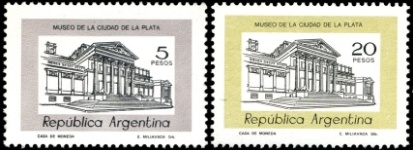the place where Paleontology and Paleoanthropology meets Philately
Argentina
Fossils, dinosaurs and other prehistoric animals, paleontologists,
Natural History Museums and fossil found places on stamps and postmarks
of Argentina
| << previous country | back to index | next country >> |
Contents:
- Country overview
- Philately of Argentina
- Official stamps of Argentina related to Paleontology
- Other stamps of Argentina to consider
- Postal stationery of Argentina related to Paleontology: prehistoric animals
- Other postal stationery of Argentina to consider
- Commemorative postmarks of Argentina related to Paleontology
- References
- Acknowledgements
Argentina, officially the Argentine Republic, is a federal republic located in southeastern South America. Sharing the bulk of the Southern Cone with its neighbour Chile, it is bordered by Bolivia and Paraguay to the north; Brazil to the northeast; Uruguay and the South Atlantic Ocean to the east; Chile to the west and the Drake Passage to the south.
The country is the second-largest in Latin America, and the largest Spanish-speaking one. Argentina claims sovereignty over part of Antarctica, the Falkland Islands, South Georgia and the South Sandwich Islands. [R1]
Since the discovery of dinosaur remains in the Neuquen basin in 1882, Argentina has gained the title of Land of the Giants.
The tittle was reinforced by the discoveries of titanosaurs like Argentinosaurus, Dreadnoughtus, Notocolossus, Puertasaurus, and Patagotitan.
The study of this diverse group of sauropod dinosaurs embrace an extensive list of important contributions, which started with Richard Lydekker’s pioneering work on Patagonian dinosaurs. [R11]
Some of these giants can be seen on Argentinian stamps and postmarks.
Argentine postage stamps were first issued in 1858. [R2]
The first Paleontology related stamp issued almost a century later and shows most famous paleontologist of the country: Mr. Florentino Ameghino who formed one of the largest collections of fossils of the world at the time, which served him as the basis for numerous geological and paleontological studies.
The La Plata Museum is a Natural History Museum in La Plata, houses 3 million fossils and relics, building of the museum depicted on many stamps Argentina since 1933, these stamps should be considered by Paleophilatelic collectors for their collections.
Official stamps of Argentina that related to Paleontology: fossils, dinosaurs and other prehistoric animals, paleontologists
| 30.11.1956 "Florentino Ameghino" [1] | ??.??.1957 "Florentino Ameghino" [1] | 04.04.1992 "National Parks" [2] |
 |
 |
 |
| 02.05.1992 "Dinosaurs" | 28.11.1998 "Dinosaurs" | 10.03.2001 "Cenozoic Mammals" |
 |
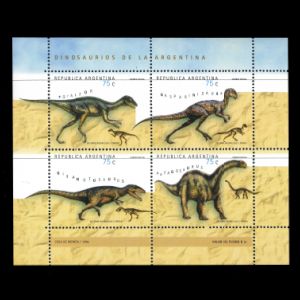 |
 |
| 02.04.2001 "Antarctic Institute" [3] | 10.11.2001 "Museums" | 28.04.2012 "200th Anniversary of Natural Sciences Museum" |
 |
 |
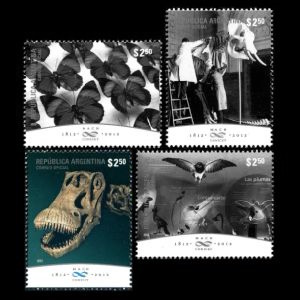 |
| 25.03.2014 "Research of Antarctica" | 09.03.2015 "Argentina in Antarctica" | |
 |
 |
|
Notes:
[1] Florentino Ameghino (1854 -1911) was an Argentine naturalist, paleontologist, anthropologist and zoologist. He formed one of the largest collections of fossils of the world at the time, which served him as the basis fornumerous geological and paleontological studies.
He also investigated the possible presence of prehistoric man in the Pampas and made several controversial claims about human origins in South America.
In 1902 Florentine Ameghino became the first Argentine director of the “Bernardino Rivadavia" Argentine Natural Sciences Museum. The Museum (MACN — CONICET) is the oldest Natural History Museum in the Argentine Republic, which celebrated its 200th anniversary in 2012.
The paleontology section of the Museum is notable for its dinosaur collection that includes Carnotaurus, Eoraptor, Herrerasaurus and Patagosaurus as well as some a Cenozoic animals such as Glyptodon, Macrauchenia, Megatherium and Smilodon.
Florentino Ameghino s shown on the following Argentinian stamps and postmarks:
- 1956: definitive stamp, MiNr. 649
- 1957: service-stamp, MiNr. 90
- 2011: postmark "Century since death"
[2] One stamp of the set shows a landscape of the Monumento natural Bosques Petrificados (the Natural monument Petrified Forest).
 This park is a protected area located in the northeast of the province of Santa Cruz, in the Argentinean Patagonia.
It was created in 1952 with the purpose of preserving an area
with a significant number of remarkably preserved petrified trees.
The region that currently occupies the petrified forest is part of a geological formation
whose antiquity corresponds to the upper Jurassic, approximately 150 million years ago.
About 150 million years ago, during the late Jurassic period, the area
occupied by this national park had a stable climate with abundant
moisture. Dense forests with giant trees grew here, among which were
Araucaria mirabilis, an ancient relative of modern species of
Araucaria, a kind of evergreen conifer.
This park is a protected area located in the northeast of the province of Santa Cruz, in the Argentinean Patagonia.
It was created in 1952 with the purpose of preserving an area
with a significant number of remarkably preserved petrified trees.
The region that currently occupies the petrified forest is part of a geological formation
whose antiquity corresponds to the upper Jurassic, approximately 150 million years ago.
About 150 million years ago, during the late Jurassic period, the area
occupied by this national park had a stable climate with abundant
moisture. Dense forests with giant trees grew here, among which were
Araucaria mirabilis, an ancient relative of modern species of
Araucaria, a kind of evergreen conifer.This changed at the start of the Cretaceous period, when volcanic eruptions, which coincided with the start of upthrusting of the Andes mountains, buried some of the Patagonian territory in ash and lava. Part of the forests covered by ash were subjected to the processes of petrification.
Some of the fossil trees are up to 30 m long and have a diameter of 2 meter. [R5] One of these trees depicting on the right side of the stamp (see on the right).
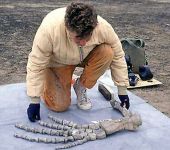


[3] The stamp at the top-right corner of the “Antarctic Institute” block shows a scientist with a fossil of a fin from a Plesiosaurs. A similar figure is drawn in the middle of the “Research Antarctica” block from 2014. Both issues are based on a famous photo that can be found in many articles in the internet.
Plesiosaurs lived for millions of years in the then-warm southern ocean surrounding Antarctica, with adults growing as large as 10 meter long. With diamond-shaped fins they could "fly" through the water much as penguins do now, as shown on Argentinian stamp in 2014. [R3]
Other stamps to consider: Natural History Museums, fossil-found sites, contributors to Paleontology and Paleoanthropology science
| 14.01.1933 "The 50th Anniversary of the Founding of La Plata" [O1] | 11.01.1958"City of La Plata 75th Anniversary" [O1]
The stamp was available until 28.02.1962 |
22.10.1966"Scientists" [O4] [O5] [O6] |
 |
 |
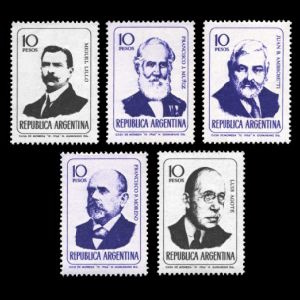 |
| 28.06.1975 "Pioneers of Antarctica" [O5] | ??.02.1976 "Moon valley" [O2] | 10.01.1977 "Moon valley"[O2] |
 |
 |
 |
| 25.07.1978 "La Plata Museum" [O1] | 08.09.1978 "La Plata Museum" [O1] | 16.08.1980 "University of La Plata" [O3] |
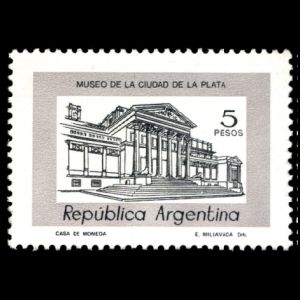 |
 |
 |
| 20.11.1982 "La Plata City Century" [O1] | ||
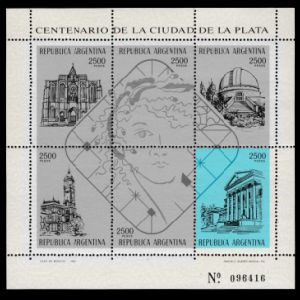 |
|
|
| 20.04.1996 "Mediciners" [O6] | 17.05.1997 "University of La Plata" [O3] | 25.09.1999 "National Parks" [O2c] |
 |
 |
 |
| 11.05.2002 "150 years since birth of Dr Francisco P Moreno" [O5] | 29.06.2002 "Landscapes" [O2] | 19.07.2003 "Landscapes" [O2] |
 |
 |
 |
| 25.08.2007 "Tourism - National Route 40" [O2] | 01.10.2018 "Landscapes (surcharged)" [O2] | |
 |
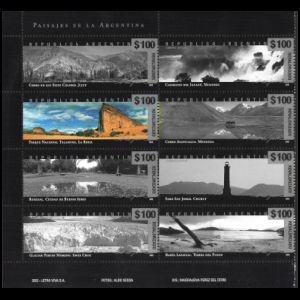 |
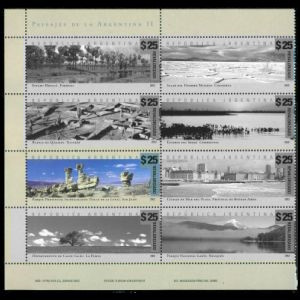 |
| ??.??.2023 "Landscapes" | ||
 |
|
|
Notes:
[O1] The Museum of La Plata is the Natural History Museum in La Plata, Argentina.
The museum, connected with the National University of La Plata, houses one of the most important paleontological and anthropological collections in South America.

|

|
|
The main entrance to the museum and one of the Smilodons at the entrance. Both image are from Wikipedia |
|
The first collections were donated by the naturalist Francisco Pascasio Moreno, founder and first director of the Museum.
The current collection of the museum contains around 4 million items, mostly from Argentina and other South American countries. The permanent exhibits is organized in 20 rooms located over two floors. The exhibits display the entire natural history of the Earth from the formation of the universe and planet Earth through life development to the origin of the human being and its cultures. [R9]
Two Smilodons sculptures srand at the entrance of the museum.
The building of the Museum of La Plata shown on the following stamps of Argentina (the Smilodon statues can even be seen on some of the stamps!):

|
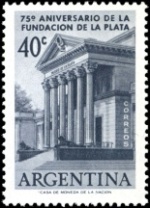
|
| Argentina 1982, MiNr. 1604, Scott: 1400f | Argentina 1958, MiNr.: 667, Ssott: 670 |
- 1933: The museum is on the background on the stamp with face value of 30C
- 1958: The stamp dedicated to anniversary of La Plate city show the museum building
- 1978: Between July 25 and August 30 post of Argentina issued five definitive stamps of famous buildings. The first stamp of the set shows the building of the museum.
- 1982: The stamp on the bottom-right corner of the Mini Sheet shows the building of the museum.
[O2] Many of Argentinian National Parks are also great fossil found places.
[O2a]
Ischigualasto and Talampaya
National Parks are on the list a heritage site by UNESCO for its paleontological and archeological values.
These two contiguous parks, Ischigualasto / Talampaya Natural Parks,
extending over 275,300 ha in the desert region on the western border of
the Sierra Pampeanas of central Argentina, contain the most complete
continental fossil record known from the Triassic Period (245-208 million years ago).
The oldest dinosaur fossils, known to date, were discovered in the Upper Triassic Ischigualasto Formation.
Thes fossils include several basal (primitive) dinosaurs, including Eoraptor (depicted on stamp of Argentina in 1998)
and Herrerasaurus (depicted on stamp of South Korea in 2010).
Six geological formations in the parks contain fossils of a wide range of ancestors of mammals,
dinosaurs and plants revealing the evolution of vertebrates and the nature of
paleo-environments in the Triassic Period.
[R4]

|

|

|
| Argentina 1976, MiNr.: 1234, Scott: 1050. | Argentina 1977, MiNr.: 1288, Scott: 1108. | Argentina 2003. MiNr.: 2841, Scott: 2248e. |
- 1976 and 1977: both times as part of definitive sets. The stamp from 1977 issued with and without watermark.
- 2003: the left stamp on the third row from top,
surcharged in 2018.
These surcharged stamps were not sold in post offices or at the online store or the Argentinian Post, but by the private post operator, “Postal Unit”. These stamps were used by Postal Unit on their letters for business and private purposes.
[O2c] Landscapes of Talampaya National Park shown on the following stamps:
- 1999: the stamp with the fox
- 2002: the left stamp on the second row from top,
surcharged in 2018.
These surcharged stamps were not sold in post offices or at the online store or the Argentinian Post, but by the private post operator, “Postal Unit”. These stamps were used by Postal Unit on their letters for business and private purposes. - 2007 one of the stamps from a long strip dedicated to National Parks of Argentina (position 8). The selvages includes some text and images about every landscape.

|

|

|
| Argentina 1999, MiNr.: 2504, Scott: 2077. | Argentina 2002, MiNr.: 2739, Scott: 2190c. | Argentina 2007 MiNr.: 3151, Scott: 2447h. |
[O3] University of La Plata holds one of the most important paleontological and anthropological collections in South America. [R6]
The University shown on the following stamps:
- 1980: the building of the University
- 1997: the emblem of the University
[O4] Juan Bautista Ambrosetti was an Argentine archaeologist and naturalist.

|
| Argentina 1966, MiNr.: 942, Scott: 905 |
In 1890 he published "Observations on the Oligocene fossil reptiles of the Tertiary lands of the ancient Paraná" (original name: “Observaciones sobre los reptiles fósiles oligocenos de los terrenos terciarios antiguos del Paraná” ) in the bulletin of the National Academy of Sciences of Córdoba. In this article he described some fossils from collection of Entre Ríos Museum in Paraná City, such as prehistoric lizard Propodinema from late Miocene (9.0 - 6.8 million year ago) (nowadays Propodinema is a synonym of Tupinambis). Some prehistoric crocodiles of genus Oxysdonsaurus and Proalligator.
Ambrosetti published a second article a few years later in the bulletin of the Argentinian Geographic Institute. “Contributions to the study of Oligocene fluvial tortoises in the old tertiary land in the Paraná” (original name: “Contribución al estudio de las tortugas fluviales oligocenas de los terrenos terciarios antiguos del Paraná”). In this article he described some prehistoric tortoises of Platemys genus from collection of Parana Museum. [R8]
Juan Bautista Ambrosetti shown on the following Argentinian stamps:
- 1966: in "Scientists" stamps set (see on the right), MiNr. 942
[O5] Francisco Pascasio Moreno (May 31, 1852 – November 22, 1919) was a prominent explorer and academic in Argentina and famous collector of fossils of Argentina.
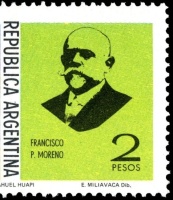
|
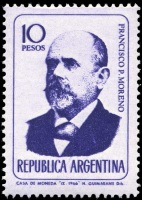
|
| Argentina 1975, MiNr.: 1219, Scott: 1068. | Argentina 1966, MiNr.: 944, Scott: 807. |
In 1880, Moreno went to France, where he spoke at a meeting of the Anthropology Society of Paris, discussing two prehistoric skulls he had unearthed in Río Negro territory. He believed one was from the Quaternary period, and the other had ritual deformation in a manner similar to the skulls of the Aymara people of the Andes and Altiplano. In 1888, he founded the La Plata Museum of Natural History (building of the museum can be seen on many Argentine stamps), the most important of its kind in South America, that houses 3 million fossils and relics. [R7]
Francisco Pascasio Moreno shown on the following Argentinian stamps:
- 1966: in "Scientists" stamps set (see on the right), MiNr. 944
- 1975: in "Pioneers of Antarctica" stamps set (see on the right), MiNr. 1219
- 2001: "150 years since birth of Dr. Francisco P. Moreno", MiNr. 2720
[O6] Francisco Javier Muniz (21 December 1795 – 8 April 1871) was an Argentine colonel, legislator, medical doctor, fossil collector and amateur paleontologist.

|

|
| Argentina 1996, MiNr.: 2297, Scott: 1922a | Argentina 1966, MiNr.: 945, Scot: 808 |
Muniz stayed in contact with Charles Darwin, with whom he exchanged some letters and articles. It was Darwin who convinced Muniz in 1845, to send fossil of a sabertooth cat which Muniz described and named as Muni-felus bonaerensis, in Gaceta Mercantil (local newspaper) to Natural History Museum for investigation. Experts of the museum ascribed the fossil to Smilodon bonaerensis species. [R10]
Francisco Javier Muniz shown on the following Argentinian stamps:
- 1966: in "Scientists" stamps set (see on the right), MiNr. 945
- 1996: in "Mediciners" stamps set (see on the right), MiNr. 2297
Postal stationery of Argentina related to Paleontology: prehistoric animals
| 10.03.2001 "Prehistoric Animals" | ||
 |
|
|
Other postal stationery to consider: contributors to Paleontology and Paleoanthropology science
| 13.12.2019 "National Exhibition of Youth Philately - Juvenex 2019 - tribute to Francisco Pascasio Moreno" [O5] | ||
 |
|
|
Postmarks of Argentina that related to Paleontology: dinosaurs and other prehistoric animals, their fossils, paleontologist, Charles Darwin
Legend is here| 06.08.1961 "50 years since death of Florentino Ameghino" [Sp] [1] - |
29.10.1961 "10th anniversary of Natural History Museum of Argentina" [Sp] | 22.09.1975 "VI Geological Congress of Argentina" [Sp] - |
 |
 |

|
| 08.08.1986 "75 years since death of Florentino Ameghino" [1] [Sp] - |
02.05.1992 "Dinosaurs" [FDC] | 17.12.1998 "Paleontology Association of Argentina" [Sp] |
 |

|  |
| 28.11.1998 "Dinosaurs" [FDC] | 10.03.2001 "Prehistoric animals" [FDC] | 09-24.03.2001 "Mammals and Dinosaurs of Argentina" [Sp] - |

|
 |
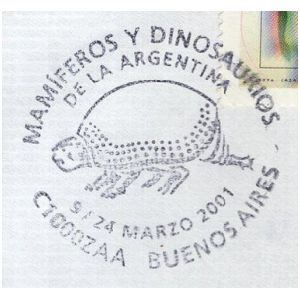 |
| 13-17.03.2002 "1st Congress ‘Osvaldo A. Reig’ of Basic and Evolutionary Vertebrate Paleontology and History and Philosophy of
Science in Buenos Aires" [Sp] - |
29.11.2009 "Bicentenary of the birth of Charles Darwin" [Sp] | 29.11.2009 "150th Anniversary of the publication of his most famous work On the Origin of Species by Means of Natural Selection" [Sp] |
 |
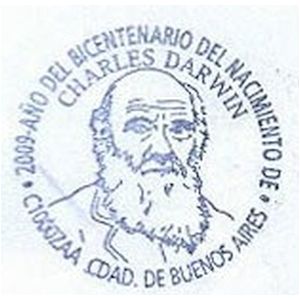 |
 |
| 22.02.2010 "Plesiosaurus discovery" [Sp] | 18.06.2011 "Centenary since death of Florentino Ameghino" [1] [Sp] | 09.03.2015 "Argentina in Antarctica" [FDC] |
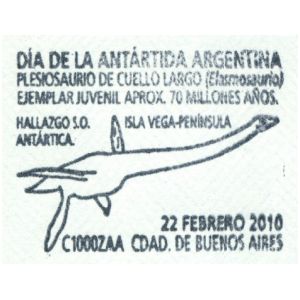 |
 |
 |
| 06.05.2024 “The 25th anniversary of Casa Ameghino Museum in Luján City” [Sp] | ||
 |
 |
|
References:
- [R1] Argentina: Wikipedia, WikiTravel, FlagCounter.
- [R2] Postal History and Philately of Argentina:
Wikipedia,
Links to official website of the Post Authority, stamp catalog and a list of new stamps of Argentina are here - [R3] Plesiosaur Baby Plesiosaur bones found in Antarctic by NBC News
- [R4] Ischigualasto / Talampaya Natural Parks: UNESCO, Wikipedia
- [R5] Bosques Petrificados Natural Park: Wikipedia
- [R6] University of La Plata: Official website
- [R7] Francisco Pascasio Moreno: Wikipedia encyclopedia.com
- [R8] Juan Bautista Ambrosetti: Wikipedia, ecured.cu.
- [R9] The Museum of La Plata Wikipedia, Official website (on Spanish).
- [R10] Francisco Javier Muñiz Wikipedia
- [R11] Giant Dinosaurs of Argentina paleonerdish.wordpress.com
Acknowledgements:
Many thanks to
- Dr. Peter Voice from Department of Geological and Environmental Sciences, Western Michigan University, for reviewing the draft page and his valuable comments.
- Fellow collector Romina Aimar from Santa Rosa, province of La Pampa in Argentina, for her help to get some information about Argentinian stamps and especially for her translation of some Spanish articles.
| << previous country | back to index | next country >> |

